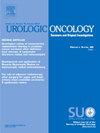ARAMIS试验非转移性去势抵抗性前列腺癌患者倾向匹配队列中他汀类药物的使用与肿瘤预后。
IF 2.4
3区 医学
Q3 ONCOLOGY
Urologic Oncology-seminars and Original Investigations
Pub Date : 2025-03-01
DOI:10.1016/j.urolonc.2024.08.023
引用次数: 0
摘要
导言:观察性研究表明,他汀类药物的使用与前列腺癌(CaP)的预后之间存在有利的关联,但随机对照试验的数据仍不确定。我们的研究以III期ARAMIS研究为背景,探讨了他汀类药物的使用与生存结果之间的关系:我们回顾了 ARAMIS 试验中的所有 1,509 名患者。基线确定了他汀类药物的使用情况。使用倾向得分匹配模型将他汀类药物使用者与非使用者进行1:2匹配。主要终点是无转移生存期(MFS)。将他汀类药物使用者和非使用者的无转移生存期绘制成 Kaplan-Meier 曲线,并在 ARAMIS 试验臂中进行比较。使用倾向匹配队列并结合他汀类药物的使用情况和所有协变量,拟合了多变量 Cox 比例危险度模型:在 ARAMIS 的 1,509 名患者中,有 334 人(22.1%)使用他汀类药物。我们将 297 名他汀类药物使用者与 550 名非使用者进行了匹配。特征看起来非常均衡。在非使用者中,ARAMIS 达罗鲁胺治疗组和安慰剂治疗组分别有 331 人(60.3%)和 219 人(39.7%)。在他汀类药物使用者中,ARAMIS 达罗鲁胺治疗组和安慰剂治疗组分别有 179 人(60.3%)和 118 人(39.7%)。总体而言,我们发现他汀类药物使用者和非使用者的 MFS 没有明显差异(HR 1.05,95% CI 0.80-1.38 P = .72)。但是,我们发现他汀类药物的使用与 ARAMIS 试验臂之间存在明显的交互作用。特别是,在安慰剂试验组中,他汀类药物的使用与 MFS 的关系更为密切(P = 0.024)。不过,这很可能是巧合,因为他汀类药物安慰剂组患者的结节阳性率高于未使用安慰剂组患者(14.3% 对 5.5%)。他汀类药物的使用同样与PSA无进展生存期(P = 0.42)、疼痛进展时间(P = 0.85)或总生存期(P = 0.15)等次要结果无关:结论:在我们对ARAMIS试验进行的二次分析中,他汀类药物使用者的MFS和次要结果与非使用者相似。这些结果表明,进一步寻求他汀类药物与酰胺类雄激素受体轴靶向药物的协同作用可能不会有结果。本文章由计算机程序翻译,如有差异,请以英文原文为准。
Statin use and oncological outcomes in a propensity-matched cohort of nonmetastatic castration resistant prostate cancer patients of the ARAMIS trial
Introduction
While observational studies suggest favorable associations between statin use and prostate cancer (CaP) outcomes, data from randomized-controlled trials remain inconclusive. Our study explores the relationship between statin use and survival outcomes in the context of the phase III ARAMIS study, a trial of darolutamide in the treatment of nonmetastatic castration-resistant prostate cancer.
Methods
We reviewed all 1,509 patients in the ARAMIS trial. Statin use was identified at baseline. Statin users were matched 1:2 with nonusers using a propensity score matching model. The primary endpoint was metastasis-free survival (MFS). Kaplan-Meier curves were plotted for MFS comparing statin users and nonusers across ARAMIS trial arms. A multivariate Cox proportional hazards model was fitted using the propensity-matched cohort and incorporating statin use and all covariates.
Results
Of the 1,509 patients in ARAMIS, 334 (22.1%) were statin users. We matched 297 statin users to 550 nonusers. Characteristics appeared well balanced. Among nonusers, 331 (60.3%) and 219 (39.7%) were in the ARAMIS darolutamide and placebo arms, respectively. Among statin users, 179 (60.3%) and 118 (39.7%) were in the ARAMIS darolutamide and placebo arms, respectively. Overall, we found no significant difference in MFS between statin users and nonusers (HR 1.05, 95% CI 0.80–1.38 P = .72). However, we found significant interaction between statin use and ARAMIS trial arm. Specifically, statin use had a stronger association with MFS in the placebo arm (P = 0.024). However, this is likely coincidental and due to the statin-placebo patients having higher nodal positivity than the nonusers-placebo patients (14.3% vs. 5.5%). Statin use was similarly not associated with the secondary outcomes of PSA progression-free survival (P = 0.42), time-to-pain progression (P = 0.85), or overall survival (P = 0.15).
Conclusions
In our secondary analysis of the ARAMIS trial, statin users had similar MFS and secondary outcomes compared to nonusers. These results suggest pursuing further statin synergies with amide-based androgen receptor axis target agents may not be fruitful.
求助全文
通过发布文献求助,成功后即可免费获取论文全文。
去求助
来源期刊
CiteScore
4.80
自引率
3.70%
发文量
297
审稿时长
7.6 weeks
期刊介绍:
Urologic Oncology: Seminars and Original Investigations is the official journal of the Society of Urologic Oncology. The journal publishes practical, timely, and relevant clinical and basic science research articles which address any aspect of urologic oncology. Each issue comprises original research, news and topics, survey articles providing short commentaries on other important articles in the urologic oncology literature, and reviews including an in-depth Seminar examining a specific clinical dilemma. The journal periodically publishes supplement issues devoted to areas of current interest to the urologic oncology community. Articles published are of interest to researchers and the clinicians involved in the practice of urologic oncology including urologists, oncologists, and radiologists.

 求助内容:
求助内容: 应助结果提醒方式:
应助结果提醒方式:


